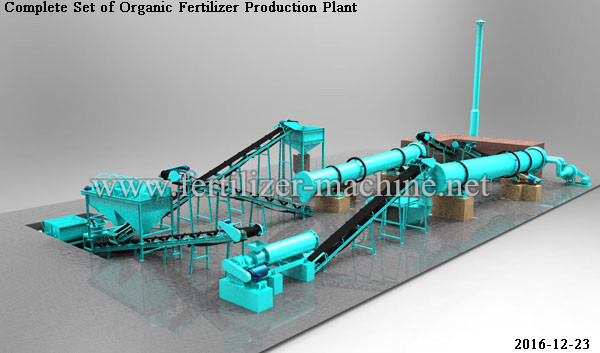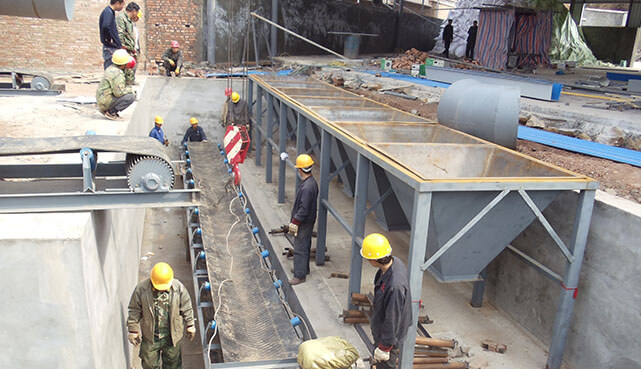—————Procedure to make organic wastes into organic fertilizer in few days
Ⅰ Organic Fertilizer Raw Materials
Ⅱ Organic Fertilizer Manufacturing Process
–Pretreatment of raw materials
–Composting process
–Compost drying/grinding/screening
–Mixing compost with other organic nutrients
–Organic fertilizer granulation method/machines
–Organic fertilizer granules drying process
–Organic fertilizer cooling process
–Commercial organic fertilizer screening
-Organic fertilizer granules packaging
Commercial organic fertilizer usually can be divided into 3 forms: powder, granule, and liquid. Granular organic fertilizer contains nutrients in a solid form that will need to be dissolved or decomposed into the soil before the nutrients results can be seen. It is is perfect for speciality crops such as herbs, spices, fruits and vegetables, and can be used on annual crops such as wheat, barley, oats, flax, lentils, peas, corn, hemp, tobacco, potatoes, mustards, fruits and vegetables, saskatoons, winter wheat and fall rye. Worldwide, organic fertilizer granules are the most widely-used fertilizer type. Therefore, today, we mainly talk about Granular Organic Fertilizer Making/Production Method, and Related Equipment.
PS: same with compound fertilizer production, organic fertilizer making process and production equipment also can be tailored just for different fertilizer plants’/factories’ requirements!
What Can Be Used As Raw Materials in Organic Fertilizer Production?
Theoretically, all biodegradable organic matters can be manufactured into quality fertilizer, so organic raw materials really differs with customers from different areas. Here, I will post several investors’ inquiries which vary substantially in raw materials to show the readers various organic fertilizer production requirements.
#1 Organic MSW
We have an Organic Project in Costa Rica, C.A. Our Foundation is focused in scientific research, conservation of tropical ecosystems, bio-technology and community development. One of our main activities now is processing waste food to produce Compost. This project is to produce organic fertilizers. Therefore, we would like to know more about the Organic Fertilizer Production Line suggested from you. We will need to process around 7-9 Tons of food waste per day coming from different sources, restaurants, food markets, etc. So, we need the shredders for 7-9 Tons/day in the beginning but our goal is to process until 15 Tons/day and to continue the process to produce compost.
#2 Animal Waste
Please quote me a 100,000 MT per year production of organic fertilizer plant using cattle manure as the major raw material base. Include: Landed Price in Manila, Philippines and Installation Cost, all in US Dollars. Thank you.
Dear All We would like to invest in unit production of compost from animal waste and in particular chicken droppings. Processed and converted into organic fertilizer bags in the local agricultural use and neighboring areas. The desert landscape of our region necessitate the use of fertilizers to poor education, but this process has become expensive and environmentally healthy one who we think in this project and please help to achieve it and embodied in reality. Regards.
#3 Palm Oil Waste
Dear Sir, We are interested in the purchase of your organic fertilizer machine. We cultivate oil palm. our oil palm plantation is about 140 hectares. we are interested in turning the wastes generated from the farm into organic fertilizer for better yield. in line with this, we request you send us the range of your machines in terms of capacity. this will include the complete equipment needed for the fertilizer production.
#4 Biogas Residue
I have 150 million us gal of digestate that I need to turn into something usable and sellable. Can your equipment help me with that?
Generally, organic fertilizer raw materials include: livestock wastes (poultry, dairy, beef, swine manures, slaughterhouse wastes), agri-food wastes (cull potatoes, crops residues, food processing biosolids), fisheries wastes (salmon mortalities, herring and shrimp wastes, fish manures, and fish processing DAF solids), shell wastes (lobster, crab, mussels, clam, oyster shell wastes), forestry wastes (bark, primary/secondary biosolids, wood-ash, sawdust, misc.wood wastes) etc. It is important to turn this valuable resource into a soil amendment and fertilizer through sound and efficient collection, transportation, treatment, and management practices.
PS: In the previous article named as Common Selection of Organic Fertilizer Materials, we have listed several kinds of organic materials commonly used in organic fertilizer manufacturing.
Organic Fertilizer Manufacturing Process: Making Method & Procedure, Production Equipment
Generally, the high-quality organic fertilizer granules production technological process consists of the following stages: production of compost, compost grinding and drying and granulation.
1. Pretreatment of raw materials
Selection and store of organic raw materials: Almost all organic wastes, except those containing high toxins, can be used as composting materials, but, to increase the soil organic matter or make a growth media, materials with a high C:N ratio, such as straw and husk of grains/cereals (e.g., rice and wheat), corn stalk, bagasse, sawdust, and other materials (e.g., tree trunks and branches), will be the main ingredient. They should be dried and stored in a nearby place.
Particle size reduction: To shorten the compost time, the waste is shredded to a uniform size and then mixed in a controlled way to ensure desired properties of the composting mixture (C/N ratio, moisture content, etc.) The straws and green manure should be cut into lengths of 5-10 cm. The wood and shoots of fruit trees and vines should be cut with shredders, grinders, or chippers.
2. Compost process design – commercial composting solution for a wide range of organic wastes
Windrow composting method: Windrow composting is the most common composting method used in North America due to its suitability for a wide range of feedstocks and facility capacities. composting can be more simply carried out in windrows. In this method waste is dumped on ground in form of piles of 1.5m to 2.5m height. (Windrow spacing needs to account for the size and type of the turner) Because of biological activities, temperatures can reach 55℃. Regular turning of the windrows assists with mixing of the materials and more importantly supply the oxygen to the bacteria, and also ensures that all parts of the windrow reach the required 55℃ essential for pathogen destruction. Turning is required every two to three days in the first two weeks when temperature is 55℃ or above. After this period frequent turning of the compost windrow is not required as less heat is generated and less oxygen is required while the compost undergoes maturation. The complete process takes 4-6 weeks.
|
|
|
| site layout of windrow composting facility | a typical outdoor windrow composting facility in Australia |
Windrow compost turner: windrow turners are generally for large facilities to turn windrows. They mix, reduce particle size, homogenize the organic material. Their larger size and horsepower allows them to turn windrows more quickly and produce a more uniform compost. Full Hydraulic Compost Turner is ideal for farm, municipal and industrial composting.
3. Finished compost grinding, drying and screening process
Finished compost are too wet and coarse to be granulated directly without further conditioning. Therefore, Preparing the compost for granulation, there are 3 steps needing to do first:
- ◆ grinding to produce a finer material (finely ground compost will allow almost all the compost to undergo the granulation process); chain crusher is used;
- ◆ screening to remove larger particles (e.g. fractions >10mm will be screened out and discarded. There is no fixed rule) rocks and unwanted debris;
- ◆ removing moisture by artificially drying the compost.
4. Mixing compost with other organic nutrients
It is necessary to boost the nutrient content of composts when targeting the granulated fertilizer market by the addition of other organic nutrients (e.g. humic acid) and mineral fertilizers.
Humic acid is useful to improve soil fertility. It is an ideal additive to boost bio-activity and improve the performance of compost or composted fertilizers, an effective agent to use as a complement to synthetic or organic fertilizers.
The addition of these organic N sources and the mineral fertilizers, such as rock phosphate and sulphate of potash, have a significant impact on improving the particle size distribution of the mix and the ease with which the resulting mix could be granulated. Horizontal mixer is used.
5. Compost fertilizer granulating method and equipment

Granulation machine: Organic fertilizer granulators include New Type Organic Fertilizer Dedicated Granulator, Flat Die Extrusion Granulator, Disc Granulator, Roller Extrusion Granulator. From the point of view of worldwide popularity, new type granulator is the winner. Because of larger capacity and “talent adaptability”, they have been sold to countries like USA, Australia, Malaysia, Thailand, Vietnam, Philippines, South Africa, Kenya, Tanzania, Holland etc. Click to learn: working principle and granulation method of New Type Organic Fertilizer Granulator
Production capacity: 2-8 tons per hour;
Parameter of organic fertilizer dedicated granulation machine:
|
Model
|
Prod Capacity (t/h)
|
Power (kw)
|
Dimension L x W x H (mm)
|
|
ALCYSL-60
|
2-3
|
37
|
3550x1430x980
|
|
ALCYSL-80
|
3-5
|
55
|
4160x1660x1170
|
|
ALCYSL-100
|
6-8
|
75
|
5385x2010x1600
|
6. Finished organic fertilizer granules drying procedure:
Why drying: Organic fertilizers in granular form must have a certain percentage of moisture, and water retention in fertilizer has a significant impact not only on the quality of the final product bust also its effectiveness, therefore the drying process is an important step in the processing of organic fertilizer.
Rotary dryer: rotary dryer is employed to reduce or minimize the liquid moisture content of fertilizer granules which are handled by bringing them into direct contact with a heated gas. organic fertilizer granules are showered through a hot gas, ambient or conditioned air stream flowing in either a co-current or counter-current direction to remove moisture. rotary dryer is widely used in the fertilizer industry.
7. Organic fertilizer granules cooling process:
Following the drying process, organic fertilizers are also cooled to remove the heat with a rotary cooler. The cooler machine slopes slightly so that the discharge end is lower than the material feed end in order to convey the fertilizer through the cooler under gravity. Organic fertilizers to be dried enter the cooler, and as the rotary cooler rotates, fertilizer is lifted up by a series of internal fins lining the inner wall of the cooler. When the fertilizer gets high enough to roll back off the fins, it falls back down to the bottom of the cooler, passing through the cold air stream as it falls.
8. Screening-rotary drum screen:
Before bagging or bulk loading, organic fertilizer granules should be screened to obtain the desired particle sizes and to remove the product size fraction. In this process, fertilizers are separated by screening into product size ranges which are useful as fertilizers and the granules larger and smaller than the useful range are reprocessed:
- ◆ fines are returned to the granulation stage;
- ◆ over-sized particles are re-crushed and recycled to the granulator along with the undersize ones;
- ◆ uniform particle size is desirable for bulk bagging and for sale.
9. Packaging:
Organic fertilizers with uniform size are fed in the automatic packaging machine transporting by belt conveyor, and bagged.
That is all!










